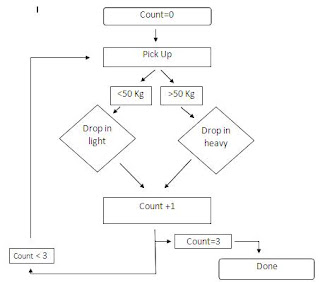Monday, February 28, 2011
Wednesday, February 23, 2011
Content is King
Importance of branches:
- Decision making for program
- Can do more when can decide because it can branch off because of different scenarios
Normally open switch examples:
- flashlight-the circuit is always open until switch is pressed which closes the circuit and the light turns on
Normally closed switch examples:
- Anything with an emergency off button-it runs until the button is pressed which opens the circuit and turns it off
Thursday, February 17, 2011
Thursday, February 10, 2011
Flowchart Problem 1
Wednesday, February 9, 2011
Inputs and outputs
Mini Switch:
-when plugged into 1 and 3 and not pressing button:
unchecked
at zero
not present
-when in 1 and 3 and pressed
checked
at one
present
-when plugged into 1 and 2 everything is flip-flopped
Potentiometer:
-range: 38-4945
NTC Resistor:
-1668
-while warm was at 1318
Motor:
-one way to change the direction of spin is by switching the wire ports
Electromagnet:
When reed switch is touched the box becomes checked
Photo transistor:
-closer light gets the number goes down
This activity was a lot of fun and I learned how to do a lot of things I did not know before I did it.
Subscribe to:
Posts (Atom)






